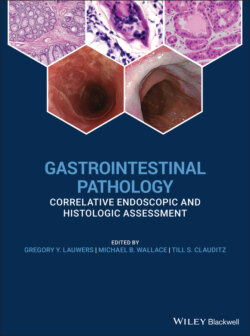Читать книгу Gastrointestinal Pathology - Группа авторов - Страница 62
Eosinophilic Esophagitis Definition, General Features, Predisposing Factors
ОглавлениеEosinophilic esophagitis (EOE) is a chronic, immune‐mediated or antigen‐mediated inflammatory condition characterized by symptomatic esophageal dysfunction and eosinophil predominant mucosal inflammation. EOE represents a type 2 (Th2) helper T cell and cytokine‐mediated disorder involving genetic predisposition, environmental exposures, and allergic background. Food‐based antigens appear to be the dominant mediators of EOE, although aeroallergens may also act as triggers in susceptible patients.
Since it was first established as a distinct clinicopathologic entity in 1993, EOE has become an increasingly recognized cause of dysphagia and esophageal dysfunction, particularly among patients refractory to medical treatment of gastroesophageal reflux disease.
EOE is reported worldwide, with highest prevalence in the United States and Western Europe. It occurs more frequently in children and young adults, although it is increasingly recognized in older adults, and is more common in males (male‐to‐female ratio of 3–4 : 1). A history of other allergic conditions may be present, such as asthma and atopic dermatitis, as well as peripheral eosinophilia, which are more common in children.
Current diagnostic criteria for EOE include a combination of clinical and pathologic features (Table 2.3).
Table 2.3 Definition of eosinophilic esophagitis and diagnostic criteria.
| Symptoms related to esophageal dysfunction |
| Eosinophil‐predominant inflammation on esophageal biopsy, characteristically consisting of a peak value of ≥15 eosinophils per high‐power field (EOS/HPF) |
| Mucosal eosinophilia is isolated to the esophagus and persists after a PPI trial |
| Secondary causes of esophageal eosinophilia excluded (Table 2.5) |
| A response to treatment (dietary elimination; topical corticosteroids) supports the diagnosis of EOE, but is not required. |
Figure 2.12 Endoscopic appearance of eosinophilic esophagitis (a) with so‐called feline esophagus appearance and (b) with extensive white microabcesses. Subtle circular rings and longitudinal furrows also present.
